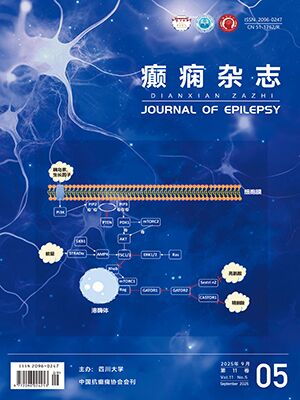| 1. |
Taylor DC, Falconer MA, Ruton CJ, et al. Focal dysplasia of the cerebral cortex in epilepsy. J Neurol Neurosurg Psychiatry, 1971, 34(4): 369-387.
|
| 2. |
Michael Wong. Mechanisms of epileptogenesis in tuberous sclerosis complex and related malformations of cortical development with abnormal glioneuronal proliferation. Epilepsia, 2008, 49(1): 8-21.
|
| 3. |
Blǔmcke I, Thom M, Aronica E, et al. The clinicopathologic spectrum of focal cortical dysplasias: a consensus classification proposed by an ad hoc Task Force of the ILAE Diagnostic Methods Commission. Epilepsia, 2011, 52(1): 158-174.
|
| 4. |
朴月善, 陈莉, 付永娟, 等. 癫痫相关局灶性皮质发育不良的临床病理学研究. 中华病理学杂志, 2007, 36(3): 150-154.
|
| 5. |
Lerner JT, Salamon N, Hauptman JS, et al. Assessment and surgical outcomes for mild type I and severe type II cortical dysplasia: a critical review and the UCLA experience. Epilepsia, 2009, 50(6): 1310-1335.
|
| 6. |
刘长青, 陈凯, 栾国明. 81例局灶性皮质发育不良Ⅱ型的临床及预后分析. 中华神经外科杂志, 2014, 30(5): 493-496.
|
| 7. |
冯占辉, 高勤, 徐祖才. 难治性癫痫伴局灶性大脑皮质发育障碍15例患者的临床特点及病理学分析. 癫痫与神经电生理学杂, 2018, 27(4): 202-205.
|
| 8. |
Cendes F, Cook MJ, Watson C, et al. Frequency and characteristics of dualpathology in patients with lesional pilepsy. Neurology, 1995, 45(11): 2058-2064.
|
| 9. |
Morales C L, Estupiñán B, Lorigados P L, et al. Microscopic mild focal cortical dysplasia In temporal lobe dual pathology: an electrocorticography study. Seizure, 2009, 18(8): 593-600.
|
| 10. |
Maria T. Hippocampal sclerosis in epilepsy: a neuropathology review. Neuropathol Appl Neurobiol, 2014, 40(5): 520-543.
|
| 11. |
李超, 汪寅, 钟平, 等. 脑节细胞胶质瘤27例临床分析. 中华神经外科杂志, 2008, 24(4): 249-251.
|
| 12. |
遇涛, 张国君, 李勇杰, 等. 导致难治性癫痫的颞叶肿瘤特点分析. 临床神经外科杂志, 2013, 10(6): 329-331.
|
| 13. |
Luyken C, Blümcke I, Fimmers R, et al. Supratentorial gangliogliomas: Histopathologic grading and tumor recurrence in 184 patients witha median follow-up of 8 years. Cancer, 2004, 101(1): 146-155.
|
| 14. |
孙康健, 周晓平, 史继新, 等. 18例罕见胚胎发育不良性神经上皮肿瘤的治疗. 临床神经外科杂志, 2008, 5(1): 40-42.
|
| 15. |
Pasquier B, Peoch M, Fabre-Bocquentin B, et al. Surgical pathologyof drug-resistent partial epilepsy: a 10-year experience with a seriesof 327 consecutive resections. Epileptic Disorder, 2002, 4(2): 99-119.
|
| 16. |
王美萍, 肖波. 皮质发育畸形与癫痫的研究现状. 神经损伤与功能重建, 2012, 7(1): 64-67.
|
| 17. |
程莉鹏, 张国君, 杨小枫. 局灶性皮质发育不良致痫的电生理机制研究现状. 中华医学杂志, 2018, 98(31): 2530-2532.
|
| 18. |
Koul R, Aithala GR, Joshi RM, et al. Lamotrigene and vigabatrin in intractable seizures in children. Neurol India, 1998, 46(2): 130-133.
|
| 19. |
Aldenkamp AP, Bodde N. Behaviour, cognition and epilepsy. Acta Neurol Scand Suppl, 2005, (182): 19-25.
|




